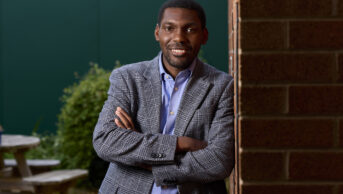Sparks, explosions and assaults on his senses were the things that attracted Sir Harry Kroto to chemistry. “I, like almost all chemists I know, was attracted by the smells and bangs that endowed chemistry with that slight but charismatic element of danger which is now banned from the classroom,” he says. But it was not quite as simple as that. According to Sir Harry, who won the Nobel Prize for Chemistry in 1996, it was his father who made him concentrate on science. A refugee from Berlin who came to England in 1937, he saw science as the best route for his son’s career. “He pushed me to ensure that my maths, physics and chemistry were up to scratch because he saw science as being the best chance of getting a job, of survival.” Sir Harry’s father certainly did not encourage his son to develop his interest in art, something that Sir Harry regrets. “I was good at art but no one said you could go to the Royal College of Arts.” If he had his time again, Sir Harry thinks he may well have studied architecture, a subject that combines his love for technology and design. As it was, the young student was unaware of this possibility. “I got to university and discovered there was a department of architecture. But it never even crossed my mind to study that,” he says. Nobel prizeIt says a lot about Sir Harry, then, that his chosen career path led to him receiving a Nobel prize, which was awarded for the discovery of C60 buckminsterfullerene — a new form of carbon. Sir Harry even describes the discovery as the result of a rather mundane idea. “The most boring little experiment (to most other people!) turned up a major advance. It was staggeringly unexpected and has opened up a whole new area of chemistry.” The discovery stemmed from work looking into the origin of long-chain molecules in space. Laboratory experiments to simulate chemical reactions occurring in the atmospheres of red giant carbon stars revealed that C60 could self-assemble. The molecule was subsequently isolated and structurally characterised. Sir Harry went on to explore and exploit the properties of C60 and fullerene chemistry, work that led him to areas such as nanotechnology. Currently, his interest lies in protein oligomers. “What fascinates me is to develop the ability to build a big molecule with exactly determined structure,” he enthuses. Despite his achievements, Sir Harry does not consider himself to be any smarter than many other scientists in his field. “I know lots of fantastically bright scientists who understand things a lot better than I do.” But he does admit to having certain qualities. “I suggested the right experiment at the right time,” he says. How research should be fundedAlthough he plays down the work that led to him receiving a Nobel prize, Sir Harry acknowledges that successful research can be difficult. In particular, he is critical of the way in which research is now funded. “I can only be a supporter of the sort of research which has turned out to be successful for me,” he says, adding: “If I had written a research proposal for that particular experiment [that led to the Nobel prize] I doubt it would have been funded.” Sir Harry has strong views on how research should be funded, but is aware that his views are unpopular. He suggests that the pot of money from which research grants come should be split into three. “The first component should be given directly to the heads of university departments.” It should be up to them to disperse those funds having taken on staff and students who they believe will come up with the goods. Part of this component should be earmarked for young scientists just launching their careers to give them the best possible start. “After all they have put the time in to choose a young scientist who is the best person for their department. Some scientist sitting on some committee assessing a research proposal has little or no feel for the situation. What’s more, the best research advances are often impossible to foresee, as was the case for C60.” A second component should be given to scientists who have a proven track record. So if someone has done good research previously, then they should receive more money to do more research. “My experience with good scientists is that if they come up with it once, somehow they can do it again,” he says. The third component is left for people who have not done quite so well. “They should get some support but should be encouraged to supplement it with money from industry or elsewhere.” The common theme to all these strands is that researchers should be allowed to do the science they want to do. “Don’t ask any questions,” says Sir Harry. “The best science is science that is unpredictable and is a big surprise. Those are the big breakthroughs.” “Peer review is the most stupid idea I’ve ever heard,” he adds, for good measure. Sir Harry backs up his arguments with his own experience as a successful research scientist. “All the big breakthroughs I made were not peer reviewed. Most of my best work was done on the backs of [other] research proposals.” He also doubts whether the way in which industry approaches research will lead to major breakthroughs. Indeed, the research and development strategies used within the pharmaceutical industry are probably not the best ones for finding the best therapies, he says. “So much of industry’s approach is ‘let’s make a better this or that, let’s make a better drug’, it is not fundamentally innovative in general.” He has a point. For example, the development of platinum-based cancer drugs sprang from research into electrolysis. A group of scientists decided to use an electrolysis medium with bacteria in it — and the bacteria died. The first conclusion was that it was the electrolysis that killed the bacteria. However, further probing revealed that during electrolysis platinum from the electrodes went into solution and it was the platinum that killed the bacteria. In an adjacent laboratory scientists working with cancer cells adapted the technique and discovered that platinum was even more cytotoxic towards cancer cells. Other examples of fundamental research leading to significant therapeutic breakthroughs include the development of the laser. This turned out to be an effective tool for solving the problem of detached retinas. “There’s no way that someone focused on eye surgery would have come up with that. It had to be from the development of the laser by a physicist who understood quantum mechanics optics and spectroscopy and then someone — possibly an eye surgeon — putting two and two together,” says Sir Harry. Another example is brain surgery and scanning techniques. Scanners were born from work originally done by physicists trying to determine the magnetic moment of a nucleus. What transpired was the development of nuclear magnetic resonance. And from this came magnetic resonance imaging. “At that time, if you knew you were going to develop a brain tumour you’d never have put your money on a physicist looking at the magnetic moment of the phosphorous nucleus. But that is what fundamental science is about. There is no way that anyone could have predicted that that experiment carried out in 1940s would end up being the most powerful tool for studying the brain and neurological processes,” he says. Sir Harry points out that the approach to research that led to these innovations required scientists to share ideas. “This is an anathema to modern science,” he adds. Secrecy in researchAlthough concerned by the secrecy surrounding research conducted by industry, Sir Harry is cautious in his criticism, primarily because he does not have a better strategic plan. But he is clear that the kind of research that leads to significant breakthroughs does not lend itself to a secretive environment. “Secrecy can never really be positive with regard to the advancement of knowledge.” The way knowledge from research is shared at the moment is a one-way process, he says. Fundamental science research conducted within universities is freely available to those working in industry but the reverse is not true. Sir Harry is well aware of the reasons behind this secrecy and understands them. Nevertheless, the findings of his research are available for others to use — he estimates that the discovery of C60 has given rise to 5,000-10,000 papers over 10 years. Although the technology is not there yet, Sir Harry can see a time when it will be possible to place radioactive atoms inside C60 and therefore isolate that atom chemically from the body and use the system to target cancer cells directly. “I’d be very surprised if, in future, C60 does not have some benefits in the pharmaceutical arena,” he says. You can hear Sir Harry speak at BPC on 28 September.
|



